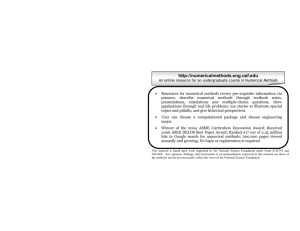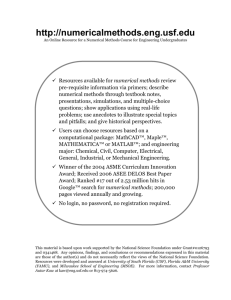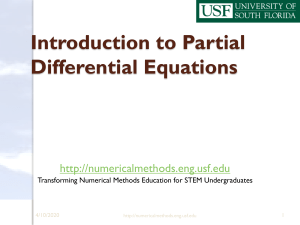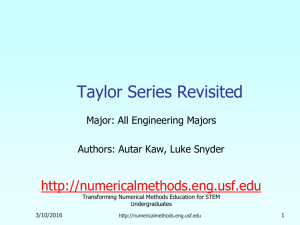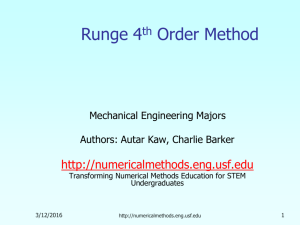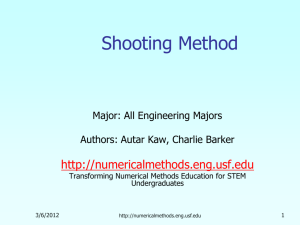Gauss Quadrature Rule of Integration
advertisement
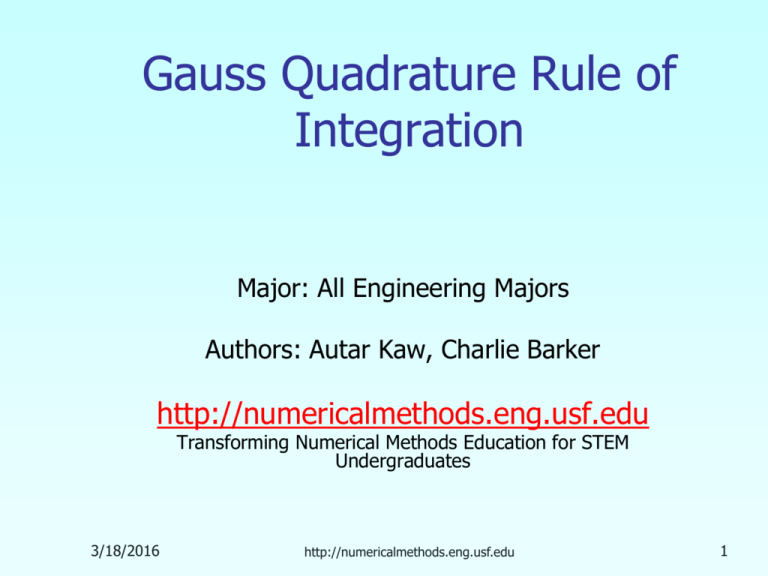
Gauss Quadrature Rule of Integration Major: All Engineering Majors Authors: Autar Kaw, Charlie Barker http://numericalmethods.eng.usf.edu Transforming Numerical Methods Education for STEM Undergraduates 3/18/2016 http://numericalmethods.eng.usf.edu 1 Gauss Quadrature Rule of Integration http://numericalmethods.eng.usf.edu What is Integration? b Integration The process of measuring the area under a curve. f ( x )dx y a f(x) b I f ( x )dx a Where: f(x) is the integrand a= lower limit of integration b= upper limit of integration 3 a b x http://numericalmethods.eng.usf.edu Two-Point Gaussian Quadrature Rule 4 http://numericalmethods.eng.usf.edu Basis of the Gaussian Quadrature Rule Previously, the Trapezoidal Rule was developed by the method of undetermined coefficients. The result of that development is summarized below. b f ( x)dx c f (a) c 1 2 f (b) a ba ba f (a) f (b) 2 2 5 http://numericalmethods.eng.usf.edu Basis of the Gaussian Quadrature Rule The two-point Gauss Quadrature Rule is an extension of the Trapezoidal Rule approximation where the arguments of the function are not predetermined as a and b but as unknowns x1 and x2. In the two-point Gauss Quadrature Rule, the integral is approximated as b I f ( x )dx c1 f ( x1 ) c2 f ( x2 ) a 6 http://numericalmethods.eng.usf.edu Basis of the Gaussian Quadrature Rule The four unknowns x1, x2, c1 and c2 are found by assuming that the formula gives exact results for integrating a general third order polynomial, f ( x ) a a x a x 2 a x 3 . 0 1 2 3 Hence 2 3 f ( x )dx a0 a1 x a2 x a3 x dx b b a a b x x x a0 x a1 a2 a3 2 3 4 a 2 3 4 b2 a2 b3 a3 b4 a4 a 2 a3 a0 b a a1 2 3 4 7 http://numericalmethods.eng.usf.edu Basis of the Gaussian Quadrature Rule It follows that b f ( x )dx c1 a0 a1 x1 a2 x1 a3 x1 c2 a0 a1 x2 a2 x2 a3 x2 2 3 2 3 3 a Equating Equations the two previous two expressions yield b2 a2 b3 a3 b4 a4 a 2 a3 a0 b a a1 2 3 4 c x a c x c1 a0 a1 x1 a2 x1 a3 x1 c2 a0 a1 x2 a2 x2 a3 x2 2 a0 c1 c2 a1 c1 x1 8 3 2 2 2 1 1 2 2 3 c2 x2 a3 c1 x1 c2 x2 2 3 http://numericalmethods.eng.usf.edu Basis of the Gaussian Quadrature Rule Since the constants a0, a1, a2, a3 are arbitrary b a c1 c2 b3 a 3 2 2 c1 x1 c2 x2 3 9 b2 a2 c1 x1 c 2 x 2 2 b4 a4 3 3 c1 x1 c 2 x 2 4 http://numericalmethods.eng.usf.edu Basis of Gauss Quadrature The previous four simultaneous nonlinear Equations have only one acceptable solution, b a 1 b a x1 3 2 2 ba c1 2 10 b a 1 b a x2 2 2 3 ba c2 2 http://numericalmethods.eng.usf.edu Basis of Gauss Quadrature Hence Two-Point Gaussian Quadrature Rule b f ( x)dx c1 f x1 c2 f x2 a ba 2 11 ba 1 ba ba f 2 3 2 2 ba 1 ba f 2 3 2 http://numericalmethods.eng.usf.edu Higher Point Gaussian Quadrature Formulas 12 http://numericalmethods.eng.usf.edu Higher Point Gaussian Quadrature Formulas b f ( x)dx c f ( x ) c 1 1 2 f ( x2 ) c3 f ( x3 ) a is called the three-point Gauss Quadrature Rule. The coefficients c1, c2, and c3, and the functional arguments x1, x2, and x3 are calculated by assuming the formula gives exact expressions for integrating a fifth order polynomial 2 3 4 5 a0 a1 x a2 x a3 x a4 x a5 x dx b a General n-point rules would approximate the integral b f ( x )dx c1 f ( x1 ) c2 f ( x2 ) . . . . . . . cn f ( xn ) a 13 http://numericalmethods.eng.usf.edu Arguments and Weighing Factors for n-point Gauss Quadrature Formulas In handbooks, coefficients and arguments given for n-point Gauss Quadrature Rule are given for integrals 1 n 1 i 1 Table 1: Weighting factors c and function arguments x used in Gauss Quadrature Formulas. Points Weighting Factors 2 c1 = 1.000000000 c2 = 1.000000000 14 x1 = -0.577350269 x2 = 0.577350269 3 c1 = 0.555555556 c2 = 0.888888889 c3 = 0.555555556 x1 = -0.774596669 x2 = 0.000000000 x3 = 0.774596669 4 c1 c2 c3 c4 x1 = -0.861136312 x2 = -0.339981044 x3 = 0.339981044 x4 = 0.861136312 g ( x )dx ci g ( xi ) as shown in Table 1. Function Arguments = = = = 0.347854845 0.652145155 0.652145155 0.347854845 http://numericalmethods.eng.usf.edu Arguments and Weighing Factors for n-point Gauss Quadrature Formulas Table 1 (cont.) : Weighting factors c and function arguments x used in Gauss Quadrature Formulas. Points 15 Weighting Factors Function Arguments 5 c1 c2 c3 c4 c5 = = = = = 0.236926885 0.478628670 0.568888889 0.478628670 0.236926885 x1 = -0.906179846 x2 = -0.538469310 x3 = 0.000000000 x4 = 0.538469310 x5 = 0.906179846 6 c1 c2 c3 c4 c5 c6 = = = = = = 0.171324492 0.360761573 0.467913935 0.467913935 0.360761573 0.171324492 x1 = -0.932469514 x2 = -0.661209386 x3 = -0.2386191860 x4 = 0.2386191860 x5 = 0.661209386 x6 = 0.932469514 http://numericalmethods.eng.usf.edu Arguments and Weighing Factors for n-point Gauss Quadrature Formulas So if the table is given for 1 g ( x )dx integrals, how does one solve 1 b f ( x )dx ? The answer lies in that any integral with limits of a can be converted into an integral with limits 1, 1 a , b Let x mt c If x a, then t 1 If x b, then t 1 Such that: ba m 2 16 http://numericalmethods.eng.usf.edu Arguments and Weighing Factors for n-point Gauss Quadrature Formulas ba c 2 Then ba ba x t 2 2 Hence ba dx dt 2 Substituting our values of x, and dx into the integral gives us b a 17 baba ba f t dt 1 2 2 2 1 f ( x )dx http://numericalmethods.eng.usf.edu Example 1 For an integral Rule. b f ( x )dx , derive the one-point Gaussian Quadrature a Solution The one-point Gaussian Quadrature Rule is b f ( x )dx c1 f x1 a 18 http://numericalmethods.eng.usf.edu Solution The two unknowns x1, and c1 are found by assuming that the formula gives exact results for integrating a general first order polynomial, f ( x ) a0 a1 x. b b f ( x)dx a a 0 a1 x dx a b x2 a 0 x a1 2 a b2 a 2 a0 b a a1 2 19 http://numericalmethods.eng.usf.edu Solution It follows that b f ( x)dx c a 1 0 a1 x1 a Equating Equations, the two previous two expressions yield b2 a 2 c1 a0 a1 x1 a0 b a a1 2 20 a0 (c1 ) a1 (c1 x1 ) http://numericalmethods.eng.usf.edu Basis of the Gaussian Quadrature Rule Since the constants a0, and a1 are arbitrary b a c1 b2 a 2 c1 x1 2 giving c1 b a ba x1 2 21 http://numericalmethods.eng.usf.edu Solution Hence One-Point Gaussian Quadrature Rule ba a f ( x)dx c1 f x1 (b a) f 2 b 22 http://numericalmethods.eng.usf.edu Example 2 a) Use two-point Gauss Quadrature Rule to approximate the distance covered by a rocket from t=8 to t=30 as given by 140000 x 2000 ln 9 . 8 t dt 140000 2100t 8 30 23 b) Find the true error, E t for part (a). c) Also, find the absolute relative true error, a for part (a). http://numericalmethods.eng.usf.edu Solution First, change the limits of integration from [8,30] to [-1,1] by previous relations as follows 30 8 1 30 8 30 8 f ( t ) dt f x dx 2 1 2 2 8 30 1 11 f 11x 19 dx 1 24 http://numericalmethods.eng.usf.edu Solution (cont) Next, get weighting factors and function argument values from Table 1 for the two point rule, c1 1.000000000 x1 0.577350269 c2 1.000000000 x2 0.577350269 25 http://numericalmethods.eng.usf.edu Solution (cont.) Now we can use the Gauss Quadrature formula 1 11 f 11x 19 dx 11c1 f 11x1 19 11c 2 f 11x 2 19 1 11 f 11( 0.5773503 ) 19 11 f 11( 0.5773503 ) 19 11 f ( 12.64915 ) 11 f ( 25.35085 ) 11( 296.8317 ) 11( 708.4811 ) 11058.44 m 26 http://numericalmethods.eng.usf.edu Solution (cont) since 140000 f ( 12.64915 ) 2000 ln 9.8( 12.64915 ) 140000 2100( 12.64915 ) 296.8317 140000 f ( 25.35085 ) 2000 ln 9.8( 25.35085 ) 140000 2100( 25.35085 ) 708.4811 27 http://numericalmethods.eng.usf.edu Solution (cont) b) The true error, Et , is Et True Value Approximate Value 11061.34 11058.44 2.9000 m c) The absolute relative true error, t 28 t , is (Exact value = 11061.34m) 11061.34 11058.44 100% 11061.34 0.0262% http://numericalmethods.eng.usf.edu Additional Resources For all resources on this topic such as digital audiovisual lectures, primers, textbook chapters, multiple-choice tests, worksheets in MATLAB, MATHEMATICA, MathCad and MAPLE, blogs, related physical problems, please visit http://numericalmethods.eng.usf.edu/topics/gauss_qua drature.html THE END http://numericalmethods.eng.usf.edu
